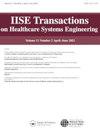基于排队理论和微模拟的疫情热点地区医院容量最大化
IF 1.5
Q3 HEALTH CARE SCIENCES & SERVICES
IISE Transactions on Healthcare Systems Engineering
Pub Date : 2022-11-18
DOI:10.1080/24725579.2022.2149936
引用次数: 2
摘要
本文提出了一个包含嵌入方程的混合整数数学程序,该程序由排队理论和杰克逊网络的概念发展而来,用于估计在极端激增条件下新冠肺炎患者护理的稳态最大潜在医院容量,在这种情况下,医院必须将其几乎所有现有资源用于大流行患者的护理。估计大流行患者护理的潜在最大医院容量有助于在大流行患者需求激增期间评估地区医疗保健能力,预测短缺,并设计准备和应对行动。为了获得这些估计并为行动提供信息,该计划确定了将不同类型的护士和医生分配到与其技能相适应的关键单位的最佳人选,以创造最佳的床位分配。提供了一种替代的试错方法,没有优化或软件专业知识的决策者可以使用该方法来获得类似的估计。在给定的资源分配下,通过直接使用排队方程可以获得各种关键的性能指标。与同一医院设计的详细离散事件模拟模型结果的比较结果表明,尽管使用基于闭合形式方程的方法需要进行额外的简化,但方程的准确性很高。关键词:微观模拟;医院容量规划;2019冠状病毒疾病流行病排队理论;浪涌规划;KPI。版权所有©2022“IISE”。本文章由计算机程序翻译,如有差异,请以英文原文为准。
Maximizing Hospital Capacity to Serve Pandemic Patient Surge in Hot Spots via Queueing Theory and Microsimulation
This paper presents a mixed-integer mathematical program with embedded equations developed from concepts of queueing theory and Jackson networks for estimating the steady-state maximum potential hospital capacity for COVID-19 patient care in extreme surge conditions, where a hospital must turn nearly all of its existing resources toward the care of pandemic patients. Estimating the potential maximum hospital capacity for pandemic patient care can aid in assessing regional healthcare capacity during surges in pandemic patient demand, predicting shortfalls, and designing preparedness and response actions. To obtain such estimates and inform action, the program determines a best assignment of a heterogeneous staff of nurses and doctors to key units appropriate for their skills to create the optimal allocation of staffed beds. An alternative trial-and-error approach is offered that decision-makers without optimization or software expertise can use to obtain similar estimates. Under a given assignment of resources, a variety of key performance indicators can be obtained through the direct use of the queueing equations. Results of comparisons to outcomes from a detailed discrete event simulation model of an identical hospital design show the accuracy of the equations to be high despite the added simplifications needed for the use of a closed-form equation-based methodology. KEYWORDS: Micro-simulation;hospital capacity planning;COVID-19;pandemic;queueing theory;surge planning;KPIs. Copyright © 2022 "IISE".
求助全文
通过发布文献求助,成功后即可免费获取论文全文。
去求助
来源期刊

IISE Transactions on Healthcare Systems Engineering
Social Sciences-Safety Research
CiteScore
3.10
自引率
0.00%
发文量
19
期刊介绍:
IISE Transactions on Healthcare Systems Engineering aims to foster the healthcare systems community by publishing high quality papers that have a strong methodological focus and direct applicability to healthcare systems. Published quarterly, the journal supports research that explores: · Healthcare Operations Management · Medical Decision Making · Socio-Technical Systems Analysis related to healthcare · Quality Engineering · Healthcare Informatics · Healthcare Policy We are looking forward to accepting submissions that document the development and use of industrial and systems engineering tools and techniques including: · Healthcare operations research · Healthcare statistics · Healthcare information systems · Healthcare work measurement · Human factors/ergonomics applied to healthcare systems Research that explores the integration of these tools and techniques with those from other engineering and medical disciplines are also featured. We encourage the submission of clinical notes, or practice notes, to show the impact of contributions that will be published. We also encourage authors to collect an impact statement from their clinical partners to show the impact of research in the clinical practices.
 求助内容:
求助内容: 应助结果提醒方式:
应助结果提醒方式:


